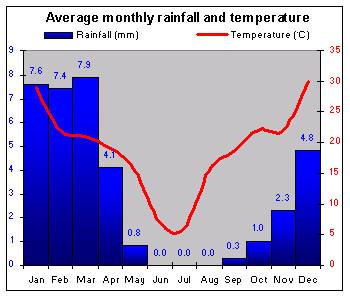COUNTRY INFORMATION |
Introduction |
Located in southwestern Africa, Namibia has an arid coastal strip formed by the Namib Desert. After many years of guerrilla warfare, Namibia won independence from South Africa in 1990. Despite the move away from apartheid, Namibia's economy remains reliant on the expertise of the small white population, a legacy of the previously poor education for blacks. Namibia is Africa's fourth-largest minerals producer. |
|
Climate |
 |
Namibia is almost rainless. The coast is usually shrouded in thick, cold fog unless the hot, very dry berg blows. |
|
People |
| Languages |
Ovambo, Kavango, English, Bergdama, German |
|
| URBAN/RURAL POPULATION DIVIDE |
|
|
|
The largest ethnic group, the Ovambo, tend to live in the sparsely populated north of the country. Whites – 60% of whom speak Afrikaans – are concentrated in Windhoek. The capital is also home to a wealthy century-old German community. Namibia's original inhabitants, the San and Khoi (once called Bushmen) now constitute a tiny, marginalized minority. The ethnic strife predicted in 1990 has not materialized. For the most part, black Namibians, predominantly subsistence farmers, have accepted the greater wealth of the white community. Families are large in Namibia; many black women have six or more children. The constitution supports gender equality and discriminates in favor of women; few, however, have official jobs or own property. Homosexuality is not tolerated. |
|
Economy |
| GNP (US$) |
3569
|
M |
GNP World rank |
126
|
|
| Inflation |
9 |
% |
Unemployment |
40 |
% |
|
StrengthsVaried mineral resources. Market conditions attractive to private investors. Rich fishing grounds. Potential of Walvis Bay as conduit for landlocked neighbors. Low external debt. WeaknessesMost goods imported. Fluctuations in mineral prices. Recessionary ripple effect of currency pegged to South African rand. Lack of skilled labor; high unemployment. Severe drought in 1996. |
|
Politics |
| Lower house |
Last election |
1999 |
Next election |
2004 |
| Upper house |
Last election |
1998 |
Next election |
2004 |
|
SWAPO guerrillas fought for and won independence from South Africa in 1990. Namibia switched from a system of apartheid to a state-wide, multiparty democracy. The center-left SWAPO has dominated politically ever since. In 1998 a constitutional amendment allowed President Nujoma to run for a third term, which he duly won in late 1999. SWAPO's main opposition comes from the center-right DTA, a coalition of 11 parties favoring free-market practices. |
|
Resources |
| Minerals |
Uranium, lead, gold, cadmium, oil, copper, diamonds, zinc, silver |
|
| Oil reserves (barrels) |
No data |
Oil production (barrels/day) |
Not an oil producer |
|
Namibia has abundant uranium, lead, and cadmium resources. Hydroelectric power and offshore diamond mining have huge potential. The Okavango river system carries more water than all South Africa's rivers combined. Large oil deposits were discovered in 2000. |
|
Health |
| Life expectancy |
45 |
Life expect. World rank |
176 |
| Population per doctor |
3333 |
Infant mortality (per 1000 births) |
62 |
|
|
|
| Principal causes of death |
AIDS, respiratory, heart, and intestinal diseases |
|
Preventive care and rural health care have top priority. Most areas lack safe water. AIDS is the leading cause of death. |
|
Education |
| Literacy |
82 |
% |
Expend. % GNP |
8 |
%
|
|
| PERCENTAGE OF POPULATION IN FULL TIME EDUCATION |
|
| Primary |
100 |
% |
Secondary |
59 |
% |
Tertiary |
7 |
% |
|
Nearly 90% of children attend primary school, but illiteracy among black adults remains a legacy of apartheid. |
|
Wealth |
| Cars |
47 |
per 1,000 population |
| Telephones |
63 |
per 1,000 population |
| Televisions |
38 |
per 1,000 population |
|
Gross disparities in wealth persist throughout Namibia: the top 1% of households consumes as much as the poorest 50%.
|
History |
In 1915, South Africa took over the former German colony as a League of Nations' mandate known as South West Africa. - 1966 Apartheid laws imposed. SWAPO begins armed struggle.
- 1968 Renamed Namibia.
- 1973 UN recognizes SWAPO.
- 1990 Independence.
- 1994 South Africa relinquishes Walvis Bay.
- 1999 President Sam Nujoma wins third term.
|
|